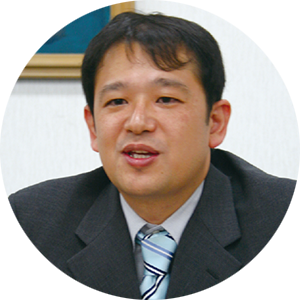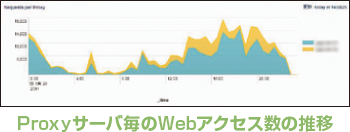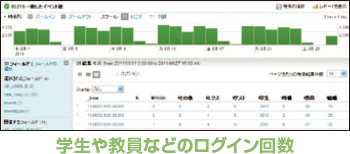product
- Why choose Splunk
- Installation record
- price
- Splunk Enterprise Security
- Splunk Phantom (SOAR)
- Splunk ITSI (Next Generation IT Operations)
- Splunk Observability Cloud
- Splunk UBA
- Macnica CSIRT App Basic
- App for Splunk for Financial Institutions
- Splunk Analytics for Hadoop
- About Apps
- Splunk Edge Hub
- What is Splunk
service
- Dashboard/SPL Creation Pack [Implementation/Building Support]
- Version upgrade service [implementation and construction support]
- Smart Security Monitoring App [Original App/Service]
- Splunk × LANSCOPE Original App [Original App/Service]
- Security Monitoring App for Box [Original App/Service]
- Cloud Security Monitoring App [Original App/Service]
- List of services
- Macnica Premium Support for Splunk (utilization support, version upgrade monitoring)
Specifications/Technical Information
Application for evaluation machine
- FAQ

Splunk
Splunk
Dokkyo University

Dokkyo University struggles with manual log analysis. Realizing efficient log analysis by focusing on Splunk's capabilities
- Manual log analysis becomes difficult due to rapid increase in logs due to system expansion
- ログ分析のためのスクリプト作成など、分析工数が増加
- Concerns over reliability due to variations in results due to log analysis methods that depend on individual skills


- Splunk with high data coverage makes log analysis more efficient
- Reduce analysis man-hours with full-text search of logs and intuitive log narrowing down by mouse operation
- Uniform analysis results by unifying and sharing log analysis methods/conditions

Dokkyo University Facility Division Information Infrastructure Development Section
Infrastructure system section manager
Mr. Kawaguchi
Rapid increase in logs from various systems as it expands
Dokkyo Gakuen University was founded in 1883 (Meiji 16) by the leaders of the Meiji era (the 16th year of the Meiji era), and was founded in 1964 in Soka City, Saitama Prefecture to commemorate its 80th anniversary. opened in Inheriting the history of the school, which introduced a German academic system, conducted rational and empirical education, and sent out many excellent human resources to the world of politics, government, and medicine, “University is a place for human development through learning.” is the founding principle of the school, and the tradition of foreign language education and international exchange has been passed down to the present day.
In addition, since Dokkyo University introduced computers for scientific calculation in 1968, it has taken the lead in tackling computerization and has actively used IT to support classes and self-directed learning. In 1996, we built the first “DAINET” (Dokkyo Academic Information NETwork) on-campus LAN system, and in the second generation DAINET-2, we implemented an authentication information management system linked to authentication VLAN and LDAP, a thin client, and so on. introduction. While enhancing security, we have improved the access environment, such as building a wireless LAN network on campus and VPN connections from off-campus.
In 2010, it evolved into the third generation, DAINET-3, and reinforced the office work system such as the document management system and groupware. At the same time, the central building with the server room, the Amano Teisuke Memorial Hall with the library and multi-purpose classrooms, and the east building with the PC classrooms are connected with 10GB optical fiber to realize network virtualization and server virtualization. are being implemented.
As the expansion progressed, the amount of logs generated by various systems increased explosively, and the conventional manual log analysis was about to collapse, according to Dokkyo University's Infrastructure Systems Section, Information Infrastructure Development Division. Mr. Naoki Kawaguchi, Chief of Staff.
“Until now, we have been extracting and analyzing logs for each system in order to gain a statistical understanding of system usage. Also, it took a long time to perform analysis work, and the huge amount of logs from firewalls, proxies, etc. was not visible.”
Dokkyo University manages more than 2,500 terminals and has about 10,000 users, including students and faculty members, which is comparable to that of a large company. It is said that the original business was hindered by log analysis alone.
“Because scripts depend on the skill of the creator, processing logs with commands causes variability and reduces the reproducibility of analysis results. It was no longer possible to continue collecting, analyzing, and creating reports.We thought that a centralized tool would be indispensable to solve this situation." (Mr. Kawaguchi)
Encounter with a unique search engine that can capture any text data

However, products that claim to provide integrated log management are expensive, and many of them take time or interrupt processing, making it difficult to find the most suitable product. Meanwhile, Mr. Kawaguchi focused on ``Splunk Enterprise'' (hereinafter referred to as Splunk), which Macnica had just started offering in Japan in 2009.
At Interop Tokyo 2009, where Splunk won the Best of Show Award, Mr. Kawaguchi learned of its existence. He felt that Splunk, which can automatically and easily capture not only logs, but also all text-format IT data such as alerts and configuration files without normalization and full-text search, was very unique.
"There is no performance degradation even with large amounts of IT data, and the ease of operation is also attractive, such as identifying and indexing imported IT data and automatically creating alerts, dashboards, and reports, as well as free searches. That was it,” says Mr. Kawaguchi, looking back on his impressions of the demonstration at the time.
Dokkyo University decided to introduce Splunk in January 2010, with the recommendation of Splunk from NETMARKS, a DAINET3 design and construction SIer. Since the license system can be set with an upper limit on the amount of logs captured per day, operation was initially started with 500MB/day. After that, due to the increase in the number of accesses from smartphones in the university, etc., the amount of logs also increased, so in March 2011, it was expanded to 5 GB / day.
When introducing it, it was also important to maintain continuity with past reports by issuing reports in the same format as the analysis results of previous scripts. With Splunk, you can create a report that feels natural even if you compare reports from the past 10 years with reports from Splunk.
Currently, reports such as the number of ActiveDirectory logins for each student/teacher, the number of LDAP password changes for each user, the number of VPN logins, etc., analysis reports on the email usage status of teachers/students, etc., as well as Web access destinations using Proxy logs It is also used for statistical reports, fraudulent terminal detection, and failure countermeasures in emergencies.
"The automatic creation and sending of reports according to a set schedule is extremely helpful. In the past, we could only display the information we wanted to see in chronological order, but Splunk's dashboard allows us to compare freely. Because we can do this, we can now see cause-and-effect relationships that we hadn't noticed before," says Kawaguchi.
In addition, the graphs to be displayed can be freely selected from more than 10 types of formats, including pie charts and bar graphs, increasing the visibility of usage status through reports. In addition, customization is also performed to exclude unnecessary logs and extract only important data. Such flexibility is also one of Splunk's strengths.
Possibility of automating even more advanced analysis and subdividing statistical processing

“With conventional log analysis, work time and analysis results differed depending on the skill of the worker, but after introducing Splunk, the automatic collection of logs and the unification and sharing of analysis methods have made it possible for anyone to perform any work. It has become possible to complete it quickly, the analysis results are uniform, and the entire work has become more efficient.I feel that the work time spent on log analysis has been cut in half.Actually, due to the increase in system utilization rate The amount of logs has also increased, so I feel that I have been able to reduce the work time by more than half."
Mr. Kawaguchi says that by reducing the number of man-hours, he will free the staff of the information infrastructure maintenance section from routine work of system management, and will be able to design new systems with higher productivity and improve services for users. hope to be able to concentrate on On the other hand, we believe that it will be possible to further dig deeper into conventional log analysis and automate advanced analysis and subdivide statistical processing, such as the correlation of analysis results and trends in system utilization rates. .
Continuing log analysis has the potential to improve the efficiency of university management and the educational environment, and was one of the objectives of building DAINET-3.
"Since Splunk has a high degree of data coverage and can collect and analyze IT data such as logs from any system or device, future changes in the system environment, such as an increase in the number of accesses from smartphones and tablet PCs, are expected. I feel relieved because I feel that I can flexibly respond to this,” says Mr. Kawaguchi, who gives his seal of approval, expressing his desire to draw out the potential of Splunk by making full use of it.
User Profile
| Dokkyo University | |
|---|---|
| URLs | |
|
Founded in 1883 as the German Society School, it opened in 1964 in Soka City, Saitama Prefecture. Teisuke Amano, known as a famous philosopher and translator of Kant's Critique of Pure Reason, served as Minister of Education in the third Shigeru Yoshida Cabinet, and served as the first president of the university. Based on the founding philosophy that “a university is a place for character development through learning,” the university focuses on seminar education, foreign language education, and international exchange based on the spirit of German liberal arts. |
|
Weekdays: 9:00-17:00
Inquiry/Document request
In charge of Macnica Splunk Co., Ltd.
- TEL:045-476-2010
- E-mail:splunk-sales@macnica.co.jp
Weekdays: 9:00-17:00





